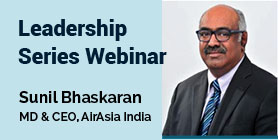Published on December 03, 2019

In the 232nd Leadership series EDGE webinar titled ‘Simplicity and Culture – Driving Cost Competitiveness in a Low Cost Carrier’, Sunil Bhaskaran, MD & CEO, AirAsia India, spoke about how a strategy based on operational simplicity and an organisational culture that values cost-consciousness is enabling AirAsia to become cost-competitive.
The aviation industry
Despite its vast scale, globally, the aviation sector has historically faced challenges of profitability owing to various reasons, primary being cut-throat pricing and highly price-elastic demand. However, in recent times, the industry has started to turn the tide, thanks largely to the worldwide emergence of the Low Cost Carrier (LCC) airlines. The LCC players have successfully disrupted the market and triggered rapid growth by providing a new value proposition, especially in emerging markets like India. Thanks mainly to LCCs, India is poised to become the third-largest aviation market globally by 2040, with industry revenue of $28.6 billion. Since the entry of the LCCs in the Indian markets in the early 2000s, the passenger traffic has grown exponentially. Reports predict a growth rate above seven percent annually over the next decade, taking passenger traffic to over 500 million. LCCs have brought flight tickets within reach of the upwardly mobile middle-class, which, combined with increasing consumption levels, has perked up the demand for air travel.
The AirAsia story
AirAsia, one of Asia’s largest and preferred LCCs joined hands with Tata Sons in 2014-15 to operate an LCC service in India. Currently, it operates out of the four hubs of Bengaluru, Mumbai, Delhi and Kolkata with a market share of 6.4 percent of the domestic market, with plans afoot to start international operations next year. Massive expansion plans include growing the fleet size to 85 aircraft by 2024, through the addition of approximately 10 to 13 aircraft annually.
Simplicity bringing success
The Air Asia low-cost model is based on simplicity and global best practices. The airline only operates economy class at a single price band, thus providing a simple and uniform customer experience. Functioning with a single aircraft type, it offers point-to-point connectivity with no connecting flights, therefore, simplifying its day-to-day operations and reducing the overheads on spares, tools and training. A 25-minute turnaround time — the best in the world — ensures better aircraft utilisation. Adopting an asset-light business model, AirAsia operates a fully-leased fleet, enabling a power-by-the-hour system of functioning and cost accrual.
A cost-competitive culture
Cost competitiveness is an integral part of AirAsia’s culture. Operational and exigent decisions are taken by key on-ground experts, including Captains and the frontline staff, to save time. The management emphasises risk-taking and agility in reversing mistakes, which prevent cost escalations. It has, in turn, led to an approach of fast decision-making and excellence in implementation, which can prove to be a major differentiator in the LCC space.
Turbo-ing ahead with technology
To further improve profitability through better productivity, AirAsia is now stressing on leveraging technology in the area of minimising manual intervention and also improving the guest experience. By promoting web as well as kiosk check-ins and enabling self baggage drop, it is reducing costs as well as augmenting guest convenience. The AVA (AirAsia Virtual AllStar) chatbot, which has ~80 percent response accuracy, has allowed AirAsia to minimise call centre costs.
With these measures, AirAsia is seeing improved productivity, which, in turn, is further enhancing its cost competitiveness.
The Leadership Series EDGE Webinar culminated in a stimulating Q&A session which saw Mr Bhaskaran answering some interesting questions. The invigorating talk gave attendees deep insights into the way of AirAsia’s working, especially in the context of the LCC space in the aviation sector.


